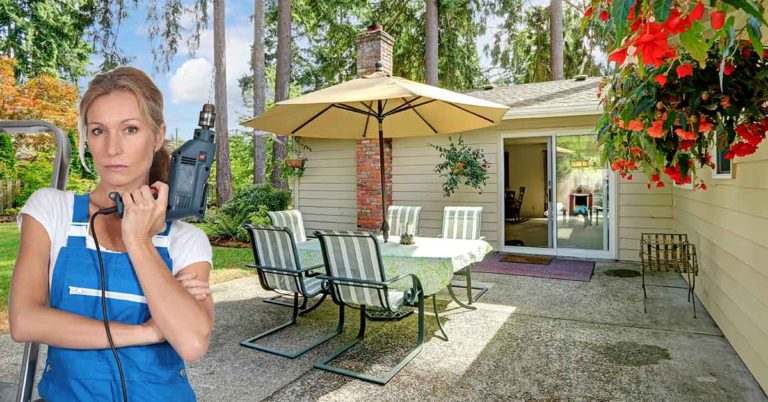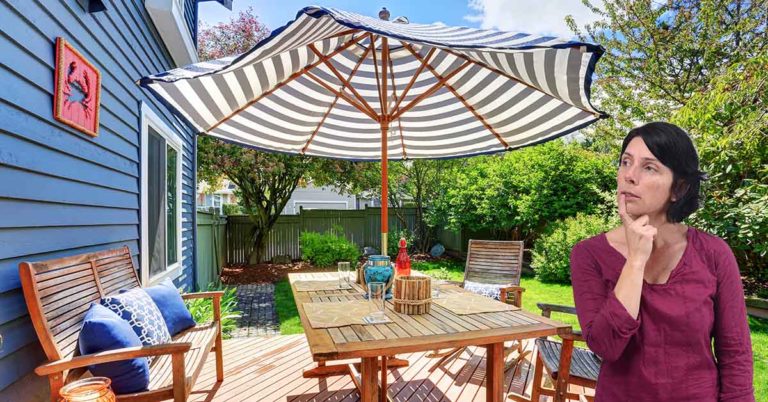5 Pros and Cons of Outdoor Rugs – Are Outdoor Rugs Good Idea?
An outdoor rug can enhance the look of your patio or balcony by leaps and bounds, but it can be equally a big hassle. So, the pros and cons of using outdoor rugs are worth considering.
But we understand that buying an outdoor carpet or rug can be quite a different experience from purchasing indoor rugs. Thus, we have broken down everything about owning an outdoor rug.
An outdoor carpet can transform your patio furniture setting by giving it a cozy, warm, and comfy edge over typical hardwood, tiles, or concrete flooring.
So, before we look at the pros and cons of buying outdoor rugs, let’s also understand them better. Here we go.
Outdoor Rug Materials, Weaves, And Types
The best outdoor rug materials (synthetic and natural fibers) can offer certain advantages over normal bare floors (more on later).
Not all outdoor rugs are the same, though. Some add softness to your floor coverings. Some offer UV protection. Some are waterproof. And others can be comfy and cozy knitted rugs like indoor carpets.
Let’s learn more about them:
Outdoor Rug Materials
Natural rugs are undoubtedly eco-friendly and softer on the skin. But outdoor rugs are usually made of synthetic fibers. They last longer, are sturdier, and do not fade as quickly.
The following are the types of synthetic materials you can consider for your outdoor carpet:
- Nylon
- Acrylic
- Polyester
- Polypropylene
These synthetic fabrics can handle heavy footfall, are water and stain-resistant, and do not fade as easily in extreme weather conditions.
Bamboo, sisal, hemp, jute, and seagrass, among others, are natural fibers for vibrant and sustainable outdoor rugs. But again, these designs, like bamboo rugs, might not be as durable as synthetic rugs.
In general, polypropylene outdoor rugs are the most popular ones because of their soft feel, even though they are synthetic.
Outdoor Rug Weaves
The type of weave or construction you choose for your outdoor carpet will also play a significant role in its appearance and, in turn, the patio or balcony look.
You can choose from these types of rug constructions:
- Hand-Hooked Rugs: Handmade construction is always the most luxurious and requires more elaborate tufting and care.
- Machine-Made Rugs: These are made in big power looms where efforts are low, and great results come at accessible prices.
- Flatweave Or Dhurrie Rugs: These are less cushiony and are woven into a delicate straight pattern.
There are also low-pile loops, cut and loop patterns, and diamond patterns, among others.
Types Of Outdoor Carpets
Apart from the weave and construct, the cuts of each carpet roll also determine the type of carpet. Here are a few of them:
- Broadloom Rolls: They are also known as tufted carpets. It can be installed wall-to-wall by laying it against carpet padding. It can also be cut to size. Thus, it is pretty flexible.
- Tiles Or Planks: Carpet tiles, also known as square carpets, are small pieces cut from broadloom rolls. One can simply piece them together to form a carpet.
- Area Rugs: These smaller rugs are meant to accent only a small part of the floor (usually under the patio furniture).
Considering all these factors, one can easily select their choice of outdoor rugs for a patio, deck, or balcony. Now, we are ready to understand the perks and pitfalls of placing rugs out in the open.
Pros & Cons Of Outdoor Carpets
Outdoor rugs are aesthetic and cozy. However, they can be a big hassle to clean. So, are they worth buying? We discuss this here.
Pros Of Outdoor Rugs
The following reasons will definitely convince you to invest in a carpet for your outdoor spaces, including patios, decks, or balconies:
1. Increased Comfort
We love having a soft material under our feet. So, whenever you’re spending some quality time in your outdoor space, a soft rug or carpet will definitely increase the ease and comfort of your feet.
2. Flooring Protection
In high-traffic areas with high footfall, a soft rug will protect hardwood flooring from wear and tear (of sunlight and tread marks). Plus, the added advantage is avoiding shoe noise as you walk on this floor.
3. Budget-Friendly
Instead of investing in elite hardwood flooring or elegant tiles for your outdoor space, you can kill two birds with a stone by placing cozy rugs. This means you’ll create an elegant sitting area without spending the big bucks on the flooring.
Choose cheaper materials if you are really budget-conscious.
4. Unlimited Options
As we discussed above, several weaves and constructs of these outdoor rugs are available in various colors and styles. You can update the look of your outdoor area by just switching between these carpets.
5. Low Maintenance
An outdoor carpet is also relatively easy to clean. Most synthetic rugs and carpets can be machine washed in cold water. For a quick clean, just vacuum them every once in a while.
These points might already be having you reach your patio for carpet measurements. But hold on.
Cons Of Outdoor Rugs
The following reasons might convince you to decide against having a rug in your patio area:
1. Installing Hassles
These outdoor rugs aren’t as easy to install as they might look. You might need extra adhesives and double-sided tapes to keep the outdoor carpet in place on concrete. These also ensure that your rug is anti-slip to avoid accidents.
2. Mold Or Mildew
While these carpets are water-resistant, they aren’t entirely immune to mold and humidity issues. Especially if you’re living in a humid area, mold and mildew can frequently occur in your outdoor rugs.
3. Additional Cleaning
While these rugs are low-maintenance, there is an additional hassle of vacuuming them (no matter how infrequent). You can avoid this by just skipping on the extra outdoor carpet altogether.
4. Color Fading
Constant UV exposure leads to fading of any fabric. The same is the case with these rugs and carpets. If you keep your rug outside for long hours, it will lose its vibrancy over time.
5. Not As Pretty As Indoor Carpets
Due to their additional sturdiness, synthetic fabrics and flatweave styles are preferred for outdoor carpets.
They might not be as aesthetically pleasing as an indoor carpet made with comfy, luxe fabrics.
And many of us do not prefer rugs on our patios for these reasons.
Outdoor Rugs FAQs
And finally, we answer some of the most frequently asked questions about outdoor carpets, their installation, and their pros and cons.
Can Outdoor Rugs Spoil The Deck?
Quite the contrary, actually. Outdoor rugs often protect the floors or wooden boards used in constructing the deck. It is always a good idea to have an outdoor mat to preserve the floors against wear and tear in the long run.
But do make sure that you use carpet pads or double-sided tapes to ensure that rugs don’t shift in their place. Otherwise, they might cause some abrasion on the floor.
Is It Better To Have An Outdoor Rug?
Outdoor rugs are always good in areas with extra footfall and other high-traffic areas. They will protect the floor against these rough conditions and enhance the look of your deck or patio.
Can Rain Spoil Outdoor Rugs?
Unfortunately, if you own a cushy outdoor rug, it is prone to mold and mildew due to high moisture content. This type of rug may withhold moisture content even after line-drying it.
Generally, synthetic outdoor rug materials can withstand rain and are easy to clean, so they are a viable option.
Do Outdoor Patio Rugs Develop Molds?
No matter how water-resistant, outdoor rugs tend to get moldy and damp. This is especially true for outdoor patios in damper areas. Accumulation of dirt and grime can aid the growth of mold and mildew.
Ensure you vacuum your outdoor carpet area regularly to avoid this sticky situation. Some protective coatings can also help tackle molds before they grow.
Final Thoughts
To enhance your terrace or patio, consider decorating it with carpets.
An outdoor rug will protect your floors in the long run against scratches and damage. They are cheap and easy to install as well. And you’ll never run out of options in colors and designs.
However, cleaning your outdoor carpet can be a big pain point if you live in humid areas. Rugs in such regions can constantly develop mold and mildew over time. Some mildew and stain-resistant treatments make outdoor rugs waterproof as well.
Based on the pros and cons of buying an outdoor rug, the decision to purchase depends on the climate in your area.


